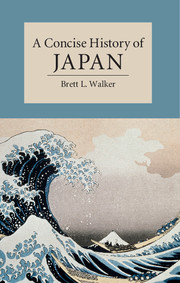Book contents
- Frontmatter
- Dedication
- Contents
- List of Illustrations
- List of Maps
- Preface
- Chronology
- Introduction
- 1 The Birth of the Yamato State, 14,500 bce – 710 ce
- 2 The Courtly Age, 710–1185
- 3 The Rise of Samurai Rule, 1185–1336
- 4 Medieval Japan and the Warring States Period, 1336–1573
- 5 Japan’s Encounter with Europe, 1543–1640
- 6 Unifying the Realm, 1560–1603
- 7 Early Modern Japan, 1600–1800
- 8 The Rise of Imperial Nationalism, 1770–1854
- 9 Meiji Enlightenment, 1868–1912
- 10 Meiji’s Discontents, 1868–1920
- 11 The Birth of Japan’s Imperial State, 1800–1910
- 12 Empire and Imperial Democracy, 1905–1931
- 13 The Pacific War, 1931–1945
- 14 Japan’s Post-War History, 1945–Present
- 15 Natural Disasters and the Edge of History
- Glossary
- Further Reading
- Index
11 - The Birth of Japan’s Imperial State, 1800–1910
Published online by Cambridge University Press: 05 March 2015
- Frontmatter
- Dedication
- Contents
- List of Illustrations
- List of Maps
- Preface
- Chronology
- Introduction
- 1 The Birth of the Yamato State, 14,500 bce – 710 ce
- 2 The Courtly Age, 710–1185
- 3 The Rise of Samurai Rule, 1185–1336
- 4 Medieval Japan and the Warring States Period, 1336–1573
- 5 Japan’s Encounter with Europe, 1543–1640
- 6 Unifying the Realm, 1560–1603
- 7 Early Modern Japan, 1600–1800
- 8 The Rise of Imperial Nationalism, 1770–1854
- 9 Meiji Enlightenment, 1868–1912
- 10 Meiji’s Discontents, 1868–1920
- 11 The Birth of Japan’s Imperial State, 1800–1910
- 12 Empire and Imperial Democracy, 1905–1931
- 13 The Pacific War, 1931–1945
- 14 Japan’s Post-War History, 1945–Present
- 15 Natural Disasters and the Edge of History
- Glossary
- Further Reading
- Index
Summary
Historians often observe that post-Meiji forces shaped the direction of Japanese empire, and for the most part this assertion is correct. Meiji policy-makers learned, through encounters like the ‘black ships’ and through international agreements like the ‘unequal treaties’, that empire building was an integral part of Western modernity, particularly the fostering of economic strength. Empire was a characteristic the Great Powers all shared and if Japan were to ever join their ranks, the island nation needed to construct an empire of its own. To be sure, this lesson was not entirely a new one for Japanese policy-makers. Japan had undertaken earlier colonial experiments, ones not necessarily forged in the crucible of encounters with the West, but rather ones born from encounters with Okinawans to the south and Ainu to the north. Satsuma domain had conquered the Ryukyu Kingdom (Okinawa) in 1609, turning the archipelago into a kind of protectorate. To the north, Tokugawa officials had justified the slow and incremental colonizing of southern Hokkaido not with the language of international agreements and global commerce, but with the language of Confucian customs and, more importantly, the necessity of trade. Eventually, the entanglement of early modern and modern forces provided the justification for Japanese expansion onto the continent and the creation of the ‘Greater East Asian Co-prosperity Sphere’, where Japan’s imperial interests would clash with those of the US and its European allies.
- Type
- Chapter
- Information
- A Concise History of Japan , pp. 201 - 217Publisher: Cambridge University PressPrint publication year: 2015



